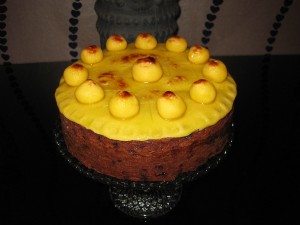From Easter day to Low Sunday
Family lore – the stories that siblings inherit from their parents and share with their children – about each other, neighbours and friends or indeed family foes help to shape our sense of inheritance. They make us into a connected living history that stretches back into the dark before, before us, and arcs over us into a future of which we know we will not always be a part.

New floral decorations for Easter Sunday Lunch
Some of these tales on the humdrum of family life we enjoy others embarrass us – even in the retrospect of long age well lived. My brother Peter never tires of telling my Easter egg story which to be honest I don’t remember but which doesn’t redound to my credit. It happened in Ireland and I believe in the family home in Boherclough Cashel. I was maybe two or at the most three and I guess mum and dad had gone down to my grandparents’ house in Boherclough to pick up my grandmother to go to Easter Mass. I still being small was left to myself and the hapless supervision of my grandfather.
Daddy Mac must have seized his chance to escape to the shed at the end of the small garden where he wiled away happy hours free from the tyranny of domestic responsibility.
I was left largely to my own devices apparently in no time found the stock of Easter eggs upstairs in the bedroom and wiled away my time eating them….every last one. By the time everyone was home from Mass I was bloated and green to the gills with chocolate. Naturally enough my Technicolor commentary upon my actions caused hilarity from which both my brother and sister never seem quite to have recovered. As my Aunt Nancy might say – there you are you have the whole of it….
So, here we are in Easter week. I’ve not quite replicated my childhood feat and I’m sitting as yet still surrounded by more Easter chocolate than I know what to do with. Somehow I also know that there will be many willing hands to help me resolve this crisis.
So, that said we are in Eastertide. This season lasted in the old Tridentine rite (and for the five hundred years before) until Ascension Thursday – in other words the forty days after Easter Sunday that Jesus remained on earth in his risen form before he ascended back into heaven. Since the Missal of Paul VI (Montini) this season of the church has been extended to six Sundays after Easter – taking us in fact to Whitsuntide.
To our modern minds three things are associated with Easter – eggs, games and cakes….
Easter cakes…or foods…well, lamb, of course, has been the favoured meat of Easter feasts at least since the Passover meal eaten by the Jews. Spring lambs are ready at around Easter and in many agrarian traditions a lamb or a kid were ritually killed on Holy Saturday to be eaten on Easter Sunday. In Greece and Malta these local traditions still continue.
The Lamb of God is symbolically Christ. According to St John’s Gospel as St John the Baptist sees Christ coming towards him at the River Jordan – after his 40 days in the desert – John exclaims…Behold the Lamb of God who takes away the sins of the world (John 1v.29) . This expostulation forms the last part of what is generally termed the Ordinary of the Mass – the Agnus Dei. The term ordinary refers to those prayers which belong to every Solemn or Sunday Mass. These are the prayers routinely set in musical composition.
Thus, lamb has been part of the earliest traditions associated with spring festivals which turn into the Christian Easter celebration. The lamb was cooked with bitter herbs (rosemary and garlic in Mediterranean traditions). Once more these accoutrements echo the meal the Jews ate standing waiting for the Angel of Death to Passover. In England I guess mint sauce – with its sweet and sour is yet another echo of the same idea.
Hot Cross buns….this delicacy for which I’ve never had a great taste – were when I was but a boy – made only the once each year….on Good Friday. Bakers opened their doors early on Good Friday morning to sell Hot Cross Buns. Trade was done by ten in the morning and then like every other shop, it closed. My memory of Good Friday as a child was everything was closed. It was rather like a Super-Sunday.
Elizabeth David’s English Bread and Yeast Cookery (a book no cook should be without) has a splendid recipe. The spices were said to be symbolic of the spices used to wrap Christ’s body; the dried fruit (currents) and wheat symbolic of the Last Supper and thus the Eucharist. The yeast – the rising agent – of the resurrection and the almond paste cross for the crucifixion. The home made variety are a million light years from the cotton-wool poison served by Supermarkets and M&S. And like most yeast cakes they’re easy to make….unlike cakes yeast once it rises never falls!
 Finally we come to the prince amongst Easter treats – The Simnel Cake. My dear friend John Dalton is no mean maker-of-cakes and has for the last several years kindly provided me with a Simnel cake. The lovely picture is of this year’s cake. I can honestly say that whilst I’m no lover of Christmas cakes in general and marzipan and almond paste in particular I make exception for Simnel cake on both counts. If he can be persuaded to part with the recipe I’ll put in on my page.
Finally we come to the prince amongst Easter treats – The Simnel Cake. My dear friend John Dalton is no mean maker-of-cakes and has for the last several years kindly provided me with a Simnel cake. The lovely picture is of this year’s cake. I can honestly say that whilst I’m no lover of Christmas cakes in general and marzipan and almond paste in particular I make exception for Simnel cake on both counts. If he can be persuaded to part with the recipe I’ll put in on my page.
But you ask who or what is Simnel….
From the fog of O’level History I pluck two names: Perkin Warbeck and Lambert Simnel. The former was a Yorkist Pretender to the throne of Henry VII. His was a serious threat since he and those around him garnered money from the court of the duke of Burgundy. Warbeck looked rather like Edward IV and it’s been thought he may indeed have been one of the many illegitimate of the king. He ended badly on the hangman’s noose at Tyburn.
Lambert Simnel’s is a happier tale, son perhaps of a baker or maybe organ builder he was an intelligent boy who attracted the attentions of a local cleric. Richard Simon found the boy easy to teach and soon had him educated in the manners of the court.
But clerical ambitions and Yorkist sympathies carried Simon’s pretences to extremes. Simon passed-off Simnel as the earl of Warwick (son of the attainted and executed George, duke of Clarence). He wasn’t anything of the kind although he got as far as a Coronation in Christ Church cathedral in Dublin as the first Edward VI. After the battle of Stoke Field (1487), Lambert fell into the hands of Henry VII.
The king made him a royal turnspit in the Tower. It’s said Simnel made this cake to please his royal master and it did. Simnel was released from the Tower and became an officer of the royal household. He may have ended as a Falconer to Henry VIII if he is the same Symnell who dies in 1525.
Bede tells us that Ēostre or Ostara ( even Austra) a proto-Germanic dawn Goddess had the month of April dedicated to her. And from her the word Easter and the games associated with eggs and dancing around eggs were similarly associated. The rest is I’m afraid rather uncertain. There is such a scramble of fact and fiction, so many traditions have coddled and flipped-over and passed back and forth between early Christian, eastern and Germanic traditions that is cannot be clear who poached what from whom… or if you like which came first….Easter‘s name or Easter’s egg…
What we do know is that by the sixteenth century that eggs and Easter are already one. There is speculation about the Lenten fast allowing an accumulation of eggs.
Certainly in monastic communities – eggs were not eaten on fast days. The monks followed the Eastern traditions of both Orthodox and Maronite Christians who take the fast to be virtually vegetarian. The decretals of Pope Gregory I (the Great) forbade dairy, milk and eggs from being consumed in addition to meat. Fish was exempted.
And the tradition of making pancakes to use up eggs was already long established part of Shrove Tuesday before Chaucer. Aquinas – the angelic doctor – forbade eggs in the periods of Lenten fast. He was ever thorough and as rigorous as he was chaste. In the medieval period local bishops routinely suspended fast rules and the Pope dispensed for dairy and eggs from the fast – particularly for a compensating monetary donation or for the proclamation of Crusade for example. There were never therefore hard and fast rules about fasting.
Today is Easter Saturday – and not as the BBC would have it last Saturday which was Holy Saturday. Tomorrow is Low Sunday.
This marks the beginning of Paschal tide – the season within Eastertide as Passiontide is within Lent. Each of the days of the Octave of Easter is kept as a Solemnity in its own right and then from Low Sunday until Pentecost the Breviary (as opposed to the Missal) keeps the prayers of Paschal tide which included each day saying the Te Deum.
Low Sunday’s gospel tells of St Thomas refusing to believe Christ is risen until he has put his hands in the Lord’s wounds.
On the Sunday after Easter Christ appears to the Apostles and the Holy women including Thomas. Christ utters the famous dictum ‘blessed yet are those who have not seen but have believed.’ These words may have been translated in Saxon times as Holy or Hallow are those….and hence (Hal)Low Sunday…
The origins of ‘low Sunday’ are obscure. It was traditionally the day when the newly baptised of Easter ‘s vigil cast off their white christening robe. It is also known as Quasimodo Sunday from the Intriot ‘ Quasi modo geniti infantes, rationabile, sine dolo lac concupiscite’ (as the newborn reaonably desire milk without guile….)
There’s a recording of the Introit here:
Quasi Modo Intriot for low Sunday
 Finally we come to the prince amongst Easter treats – The Simnel Cake. My dear friend John Dalton is no mean maker-of-cakes and has for the last several years kindly provided me with a Simnel cake. The lovely picture is of this year’s cake. I can honestly say that whilst I’m no lover of Christmas cakes in general and marzipan and almond paste in particular I make exception for Simnel cake on both counts. If he can be persuaded to part with the recipe I’ll put in on my page.
Finally we come to the prince amongst Easter treats – The Simnel Cake. My dear friend John Dalton is no mean maker-of-cakes and has for the last several years kindly provided me with a Simnel cake. The lovely picture is of this year’s cake. I can honestly say that whilst I’m no lover of Christmas cakes in general and marzipan and almond paste in particular I make exception for Simnel cake on both counts. If he can be persuaded to part with the recipe I’ll put in on my page.

